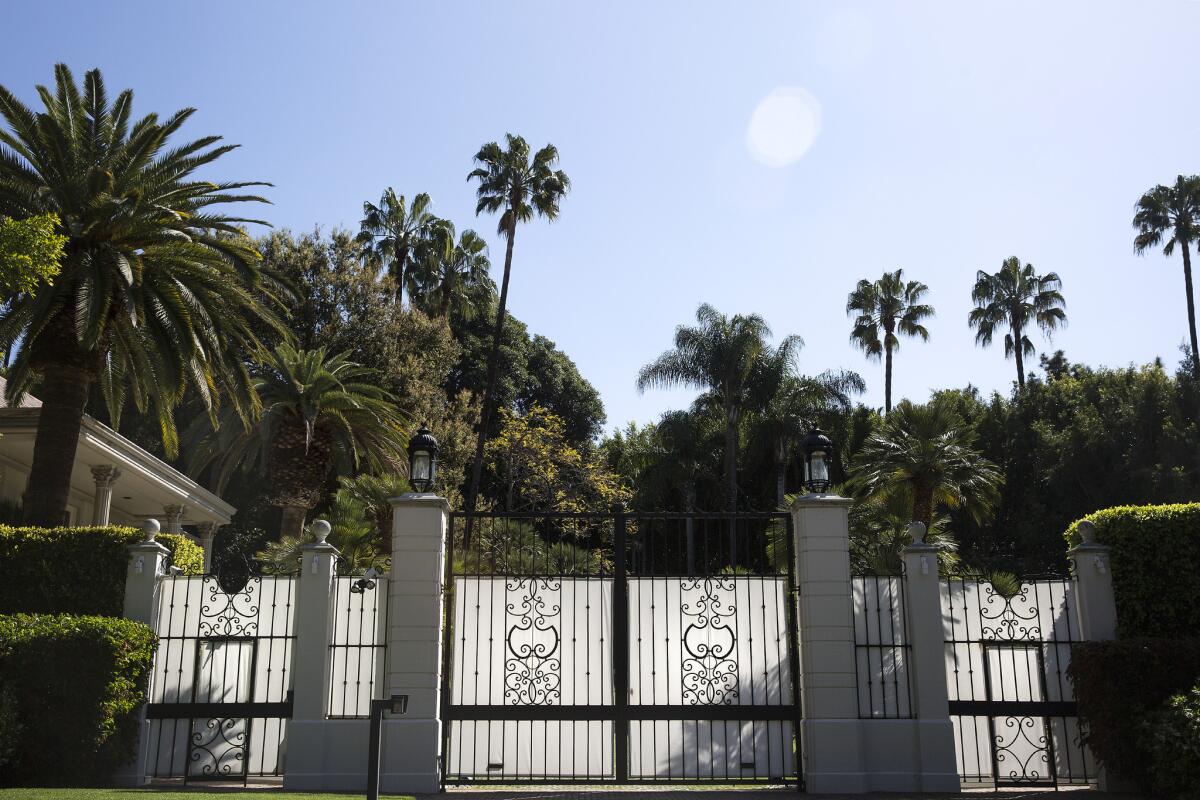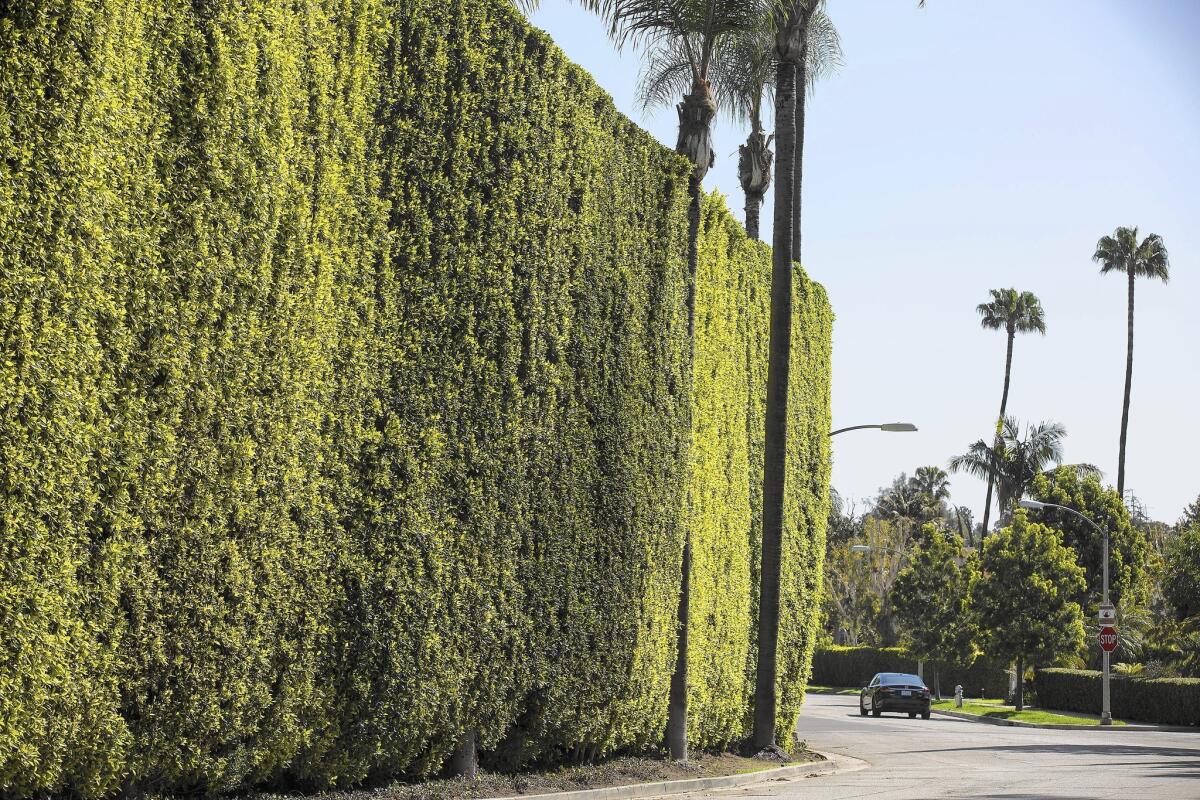Beverly Hills put a spotlight on its celebrity water wasters -- and it worked

Developer Geoff Palmer’s household used more than 12,000 gallons of water a day during a two-month period. Facing a penalty, Palmer appealed in January.
Officials in Beverly Hills say they tried it all: educational campaigns, usage restrictions and written notices for people suspected of wasting water.
Despite those efforts, the community missed its savings target every month since June, when a statewide 25% reduction in urban water consumption became mandatory amid the punishing drought. As a result, state regulators fined the city, saying publicly that its water wasters “should be ashamed.”
Water and Power is The Times’ guide to the drought. Sign up to get the free newsletter >>
About four months ago, city officials got tough. Beverly Hills sent letters to dozens of customers in November warning them of high water use and urging them to cut back. The city also began penalizing profligate users.
The letters went to entertainment industry figures such as comedian Amy Poehler, prominent real estate developers such as Geoff Palmer and other notable names. An estate owned by philanthropist and former media mogul David Geffen used an average of about 27,000 gallons of water a day between June 2 and Aug. 2 — roughly 60 times what an average Los Angeles family uses and about 9,000 gallons more per day than what Geffen was allowed.

An estate owned by philanthropist David Geffen used an average of 27,000 gallons of water a day between June 2 and Aug. 2.
Now it appears the crackdown is working. The city cut its water usage by 26% in January — its highest percentage in eight months of reporting and more than double its effort in December.
“We believe that the penalty surcharges have had an impact,” city spokeswoman Therese Kosterman said. “Many different tools are necessary in order to achieve … deep cuts in water conservation.”
To achieve the 25% cut ordered by Gov. Jerry Brown, the State Water Resources Control Board assigned California’s urban water suppliers individual conservation standards that they would be required to meet between June and February. Beverly Hills was told to slash its usage by 32% compared with 2013.
In May, city officials enacted restrictions on outdoor watering, refilling swimming pools and washing cars. The Stage D regulations also required a large majority of customers to cut their water consumption by 30%, compared with the same period in 2013. By the end of June, the City Council had approved penalty surcharges for those who failed to comply and began assessing them in November.
Between June and November, the city received scores of complaints about customers violating the Stage D regulations. Officials followed up with notices reminding these customers of the watering restrictions.
Still, Beverly Hills continually fell short of the state-mandated savings target, and in late October, the water board fined the city and three other water providers $61,000. According to the most recent state data available, the city has shaved its water use in June through January by 19% from 2013 levels.
By comparison, the Santa Fe Irrigation District persuaded its customers — including those in well-to-do Rancho Santa Fe — to cut back their water use by almost 35%. Las Virgenes Municipal Water District, whose service area includes Calabasas and Hidden Hills, has reduced consumption by 29.5%.
“The inference we’re drawing is it’s not the agency,” said Cris Carrigan, the state water board’s chief of enforcement. “The agency is providing the right tools to their customers. It’s that the customers don’t have the wherewithal to commit to conservation.
“I’m not sure why that is,” he continued. “There are other affluent communities in the state where conservation is cool. In Beverly Hills, for whatever reason, people are not motivated.”
See the most-read stories this hour >>
In a letter sent to the state in April, a city official worried that meeting a high conservation target “in such a short time may ultimately be infeasible.” The official argued that some suppliers face “specific demographic and geographic factors” that make it harder for them to meet conservation targets.
A 2014 UCLA study showed that wealthier neighborhoods typically consume three times more water than less-affluent ones. But Bruce Reznik, executive director of Los Angeles Waterkeeper, a waterway protection and restoration organization, said demographics are no excuse.
“I don’t mean to get the world’s smallest violin out, but you’ve got a constituency that has the means to do aggressive water conservation,” Reznik said. “It’s the lowest hanging fruit to turn off the sprinklers for a couple days. It’s not brain surgery.”
On Nov. 6, the city sent letters to 86 single-family residential water customers — the highest users among those who failed to meet the city’s 30% reduction mandate.
The letters covered a two-month billing cycle that generally ran from June to August. The Times obtained the letters and corresponding water bills in response to a request filed under the California Public Records Act.
All along, Beverly Hills has urged its residents to “conserve water irrespective of their financial status,” Mayor Julian Gold said in a statement. “These letters were the latest in our toolbox to encourage the top water users to be more conservation minded.”
Some of the homes where the city says the profligate water use occurred have been listed for tens of millions of dollars and feature six, nine or even 18 bathrooms. The two-month bills ranged from $2,458 to as high as $31,640 and did not include penalty surcharges.
Geffen was charged more than $30,000 for 1.6 million gallons at the property known as the Warner Estate. The city said his “allowed water usage” for that billing period was about 1.1 million gallons.
During the most recent billing cycle, ending in January, water use at the estate dropped by 56% compared with the same period in 2013, Kosterman said.
Reached by phone, a woman who identified herself as an assistant for Geffen told a Times reporter to email Geffen to request a comment.
In an email Monday, Geffen said he has been trying to get permission from the city of Beverly Hills to drill a well on his property, which covers 10 usable acres.
The well would allow him to “access the underground river that flows beneath my home instead of water from the city,” Geffen wrote. “That water is not potable and simply flows into the ocean and is wasted.”
Poehler was charged more than $2,200 for water use at a property. The usage there between May 14 and July 14 exceeded 170,000 gallons, according to her bill.
Poehler’s representatives did not return calls and emails requesting comment.
Palmer’s household used more than 12,000 gallons of water per day during the period, at a total cost of more than $12,000.
In an email to The Times, Palmer said a leaking pipe had been discovered on his property that accounted for the excess usage, though in an earlier email, he also complained that the state’s water has been misallocated.
Referring to agriculture, Palmer wrote, “This small lobby of special interests controls water that could be allocated to the 39 million residents of California who are being asked to sacrifice.... Wouldn’t you be willing to pay a little more for walnuts and pistachios than see your lawn and landscaping go dead?”
Facing a penalty, Palmer filed an appeal at the end of January.
Others who got warning letters included film director and producer Brett Ratner and Jason “Max” Mutchnick, co-creator of “Will & Grace.”
In a statement, Ratner said he was not aware of the excessive water use at his home. After investigating, he said he discovered multiple pipe leaks and promised to repair them. Subsequently, more leaks were found and Ratner is now replacing the entire water line, a spokeswoman said.
In a separate email, a representative for Mutchnick said two “substantial” leaks had been detected and have since been repaired.
Regulators have said they would consider a water supplier’s effort and look for signs of progress when deciding whether to take enforcement actions.
Beverly Hills had missed its conservation standard by increasing margins for three consecutive months until January, when the city’s savings percentage shot up even as statewide conservation continued to decline.
But 26% is well short of the city’s 32% conservation standard, and city officials say they know they are still subject to penalties.
Asked whether Beverly Hills could get fined again because it still has not met its target, the state water board’s Carrigan said, “We might do that.”
Twitter: @ByMattStevens
Times editorial library director Cary Schneider contributed to this report.
ALSO
California’s next governor: Who’s running, who’s on the fence?
‘You don’t drink the water in Gardena’: A year later, residents remain skeptical
Silicon Valley fears European backlash after Congress limits visa waiver program
More to Read
Sign up for Essential California
The most important California stories and recommendations in your inbox every morning.
You may occasionally receive promotional content from the Los Angeles Times.











